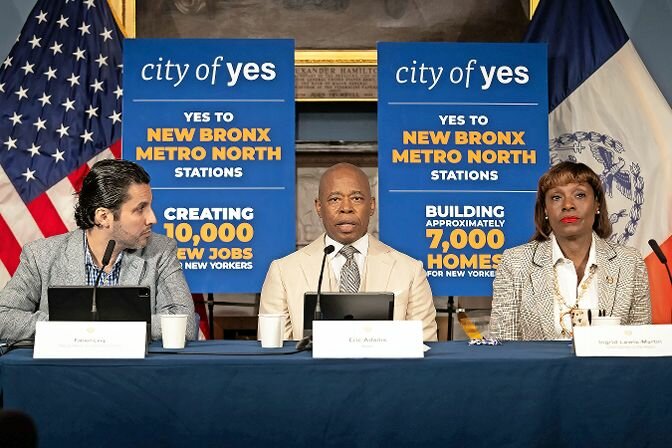NYC's City of Yes housing plan nears approval amid local concerns
The final installment in Mayor Eric Adams’ City of Yes for Housing Opportunity is moving full steam ahead as the fall begins, and the planning commission heads to a final proposal vote next month.
The City of Yes plan was sent for public review in April, allowing community boards, public officials and borough presidents the opportunity to discuss the plan with residents to provide final recommendations to the planning commission.
Dan Garodnick, director of the planning department, described the city’s housing proposal as a failure of the past.
“This has been a decades-long failure to respond to a brewing crisis where, in the last 40, years we created jobs at half the rate that we did in the prior 40 years,” Garodnick said.
The city anticipates the City of Yes housing plan will allow for 100,000 units to be created over the course of the next 15 years, aiding in solving the New York’s growing housing crisis.
According to city’s housing and vacancy survey from last year, roughly all New Yorkers are rent-burdened and, in households earning less than $50,000, 86 percent were rent burdened. The survey also found housing availability across nearly all rent levels, with low and moderate income New Yorkers finding it harder and harder to find sustainable housing. The vacancy rate for apartments priced at $2,400 or less is below 1 percent and for apartments priced at $1,100 or below the vacancy rate was .39 percent.
Thus the city’s plan to introduce a little more housing everywhere as a way of lessening the burden.
Locally, many in greater Riverdale have expressed concern over the new zoning law that would enable new residential buildings to be built without parking to accommodate it, bringing in more residents without adequate parking in a neighborhood that already relies on car travel.
The Riverdale and Spuyten Duyvil neighborhoods have two Metro-North stations and no subway stations, with the closest subway station at 242 Street and Broadway, bordering on the Kingsbridge neighborhood.
To date, city officials have been inattentive to these concerns.
“This proposal says if you have parking, keep it,” Garodnick said. “If you want to add more parking in a future development that’s fine, if you don’t want to add parking in a future development, that’s okay too.”
The planning director’s argument is the city currently sees buildings go up with far more than the minimum required number of parking spots. According to Garodnick, the city continues to see parking being delivered where it’s needed and that won’t stop with a zoning change.
Beyond parking in the housing plan, the city wants to maintain the characteristics of all the communities, but neighborhoods on the outskirts of the city have been determined as a “fundamental barrier to creating new housing units.”
Much of the Riverdale, Spuyten Duyvil and a portion of Kingsbridge, are designated as low-density neighborhoods, meaning they are far from central business districts and offer limited access to mass transit but these neighborhoods often have shorter buildings, yards and high levels of car ownership.
Part of the plan includes what City of Yes refers to as the development of town centers, which would entail building residential spaces on top of commercial businesses.
In a neighborhood like Riverdale, where strips of commercial businesses exist, many of which are small businesses, concern over developers buying out the strips that add to the character of the neighborhood have been prominent. In response, Gardonick said the city is still in conversation with the department of small business services and chambers of commerce to determine how best to proceed while affording small business owners protection from developers.
“When you do have housing above that commercial corridor it’s great for businesses, great for residents, great for the walkability of the neighborhood, great for allowing you to access the goods and services that you need without having to travel great distances,” Garodnick said.
Though the plan does not include a percentage of new developments that must be affordable housing, it includes the Univesal Affordability Preference. This program would be a tool that allows new building developments to add at least 20 percent more housing if the additional units are affordable for those earning 60 percent of the Area Median Income.
The city determines the Area Median Income at 60 percent for a family of one comes to $65,200 and goes up from there, totaling $74,580 for a family of two and $93,180 for a family of four.
The maximum rent that can be charged for 60 percent AMI for a studio apartment is $1,630, $1,747 for a one-bedroom apartment, $2,097 for a two-bedroom apartment, and $2,422 for a three-bedroom apartment.
Garodnick said the city does not anticipate any significant or dramatic changes in niehgborhoods after the approval of City of Yes for Housing Opportunity.







